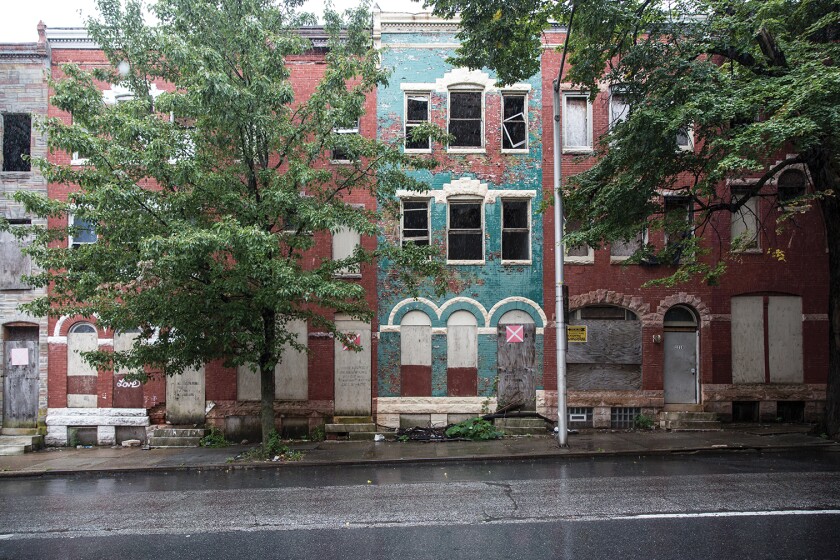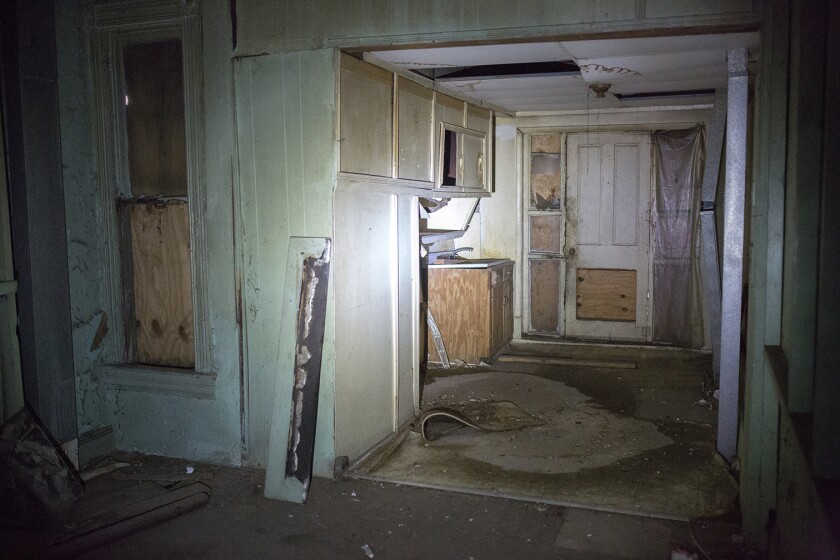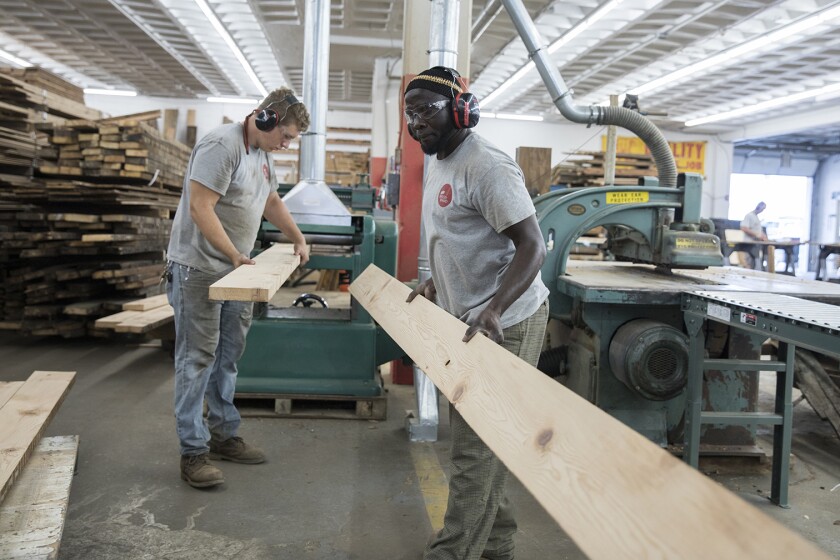On this rainy Tuesday evening, water is coming through a second-floor skylight and a broken window in the back bedroom. The whole place is dark and dirty and dank. Besides trash, the only things to be found in the house are an old railroad lantern and a pile of newspapers from 1991. A headline reads: “Dow surges again, closes above 2800.” None of this deters the one and only prospective buyer, who stops by to take a quick look inside, and seems unfazed by what he sees. He’s had his eye on this property for a couple of years, waiting for it to come on the market. Moore doesn’t join him inside; she won’t go through the door or even up the front steps.
For 10 minutes, Moore and the potential buyer huddle under a red umbrella on the sidewalk outside. “He’s going to buy it,” she says, watching him walk away.
The house is owned by the city of Baltimore, and Moore is not a real estate agent. She works for the Department of Housing & Community Development. The run-down house is being offered for sale by Vacants to Value, a program Baltimore has created to get people back into some of the many thousands of abandoned homes that plague the city. Targeting streets and neighborhoods that seem to offer the best chance of recovery, the program offers city-owned vacant homes at low prices to developers and individuals alike. Buyers must prove they can afford to purchase a property. They also have to secure funding to rehabilitate it, which costs much more than buying it. And they must do this within a prescribed amount of time, usually one year. Help is available in submitting bids and applying for an array of financial incentives and tax credits offered by the city and state of Maryland. If a property lacks a roof -- a common occurrence -- the city will often install a new one at no cost to the buyer.
In 1950, Baltimore was the sixth most populous city in America, with nearly 1 million residents. As the suburbs beckoned and industrial jobs left the city, so too did the people. Last year, the population was down to 611,648 and dropping at an accelerating pace.
But while the people have departed, the homes they occupied are still there. The list of 16,000 vacant houses has remained constant for the last decade. Of those, the city owns about 2,500, plus 7,000 empty lots. With no one to live in them, fix the roof and cut the grass, they slowly succumb to the ravages of time and weather. Entire blocks are left empty and neighborhoods are decimated.

David Kidd/Governing
But despite favorable national publicity and the initial enthusiasm that surrounded getting a home for nearly nothing, Dollar House gradually fell apart. Buyers were often unable to see a project to completion, especially after federal construction loan programs ended in the early 1980s. By 1982, buyers were responsible for obtaining financing and hiring contractors. Far less than a third of that year’s 300 buyers ever completed their renovations.
As the number of derelict and abandoned houses increased in the following decades, subsequent administrations tried to get a grip on the problem, but with limited success. As recently as a year ago, there was talk in the Baltimore City Council of reviving the Dollar House idea. But changes in the city in the last 40 years would make that a difficult proposition. Not the least of those changes is the presence of many more vacant homes and many fewer people with any interest in owning them.
Vacants to Value is different from earlier efforts in two important ways: The homes offered for sale are strategically located in places that seem to have at least some chance for a comeback. And no one is allowed to take possession without full financing in place.

David Kidd
In 2001, then-Philadelphia Mayor John Street launched what he called the Neighborhood Transformation Initiative and promised to spend $300 million. But the results were underwhelming: At the time the program launched, there were an estimated 57,000 vacant properties in the city. Street pledged to demolish 14,000, but was able to tear down just half of those. Recently resurrecting a twist on the Dollar House idea, Philadelphia now allows homeowners to purchase one of the city’s 40,000 empty lots for $1. But the lot must adjoin the homeowner’s property and cannot be worth more than $75,000.
In Cleveland, which was hit particularly hard by the foreclosure crisis of 2007, a study in 2015 by the Thriving Communities Institute found nearly 9 percent of the city’s residential structures to be vacant. A recent report from the Lincoln Institute of Land Policy stated that the number of vacants in Cleveland is at an “epidemic level.” But it’s trying, just as Baltimore and Philadelphia are. With a collaborative alliance between lenders, for-profit and nonprofit groups, Cleveland’s Slavic Village Recovery Project is completely rebuilding blighted but structurally sound homes within a 530-acre area in the city. The move-in ready homes sell for $50,000 to $69,000. Whether this targeted project can achieve enough success to create a positive spillover effect remains to be seen.
The vacant housing problem vexes smaller cities too. Gary, Ind., and Flint, Mich., have a proportionally worse problem than Baltimore, Cleveland or Philadelphia. According to a recent study by Alan Mallach of the Center for Community Progress, an urban policy think tank, some small towns and rural communities suffer vacancy rates twice those of metropolitan areas.
Mike Braverman, Baltimore’s commissioner of housing and community development, looks out over his city through an expansive window on the 13th floor of his downtown headquarters. Rattling off names of city employees, developers, contractors and even individual homeowners, he seems to know everyone who has ever had anything to do with the city’s housing. Before he was named commissioner last year, Braverman’s 30-year career with the city included stints as the legal director of the code enforcement department and as deputy commissioner of permits and code enforcement.
As a result of a reorganization by Mayor Catherine Pugh in 2017, Baltimore now has two separate housing agencies. One of them administers federally funded housing programs, and the other focuses on community development. The latter is Braverman’s territory, and Vacants to Value is part of it. “The mayor is committed to a big vision for neighborhoods,” Braverman says, adding that the division of authority allows him to “take Vacants to Value up to an entirely new level to focus on neighborhood transformation.”

David Kidd
Last year, the city of Baltimore commissioned a report on its work by the Center for Community Progress. “We have found,” the center concluded, “that the Vacants to Value program has been highly successful in certain respects, but less so in others.” The program was given high marks for targeting areas of the city where strong market conditions made housing renewal feasible. Vacants to Value falls short, the report says, when it comes to addressing crime, drugs, foreclosures and other factors that contribute to the decline of neighborhoods.
Five seasons of the TV series “The Wire” depicted the city as a dangerous and drug-infested place. The show regularly filmed in the Greenmount West neighborhood, where resident Steve Solomon recalls that the fictitious series often seemed more like a documentary. “They always filmed at night,” he says, nodding to a spot on nearby Barclay Street. “That was where all the drug dealers hung out.”
Fifteen years later, in the same spot, he is watching as a group of young kids and their moms splash in a small water park. The neighborhood, Solomon says, is “night and day from what it used to be.”
Barclay Street is at the center of the changes that have come to Greenmount West. Five years ago, Adam Kutcher and his wife Becky Eisen were looking to move there from Washington. Their enthusiasm was such that they tried to recruit some of their D.C. friends to buy on the same street so they could all raise their children together and share in Baltimore’s urban revival. “We pitched everybody that we knew,” Kutcher says, but nobody was interested. Undaunted, Kutcher and Eisen pushed on alone, buying a pair of houses on a block rife with vacant buildings for $3,000 each. It was more difficult than they had anticipated to gut, join, finance and rebuild the two deteriorating houses.

David Kidd
Around the corner from Kutcher and Eisen, a half dozen tiny rowhouses sit at the end of a short alley. Neglected for years, the houses had collapsed roofs and one had a tree growing through it. The city didn’t see any value in repaving the short street in front that was deeply cratered and nearly impossible to drive on. But SAA-EVI Development, a firm with ties to the neighborhood, did. It stepped in, buying and rebuilding several of the small homes. Just behind them sits an old warehouse that the firm hopes to purchase and replace with multifamily affordable housing. “This is our neighborhood and we like to do everything we can to help it out,” says Aleksandr Suurna, senior director of finance at the firm.
SAA-EVI has committed to the community by putting its offices in a nearby building purchased from the city, one that had been vacant for 40 years. Besides being home base for the developer, the repurposed building has apartments, retail and a restaurant. “Now it’s a cornerstone of the neighborhood,” says Suurna.
The last vacant house on Barclay Street was recently sold to a young couple who had been renting nearby. The neighborhood’s transformation, if not complete, is well on its way.

David Kidd
With city funds and a four-year, $75 million grant from the state, some 400 houses are slated to be demolished every year. Doing that isn’t as cheap as you might suppose. Using dust abatement and other means to minimize disruptions to the people still living nearby, the cost of tearing down a Baltimore rowhouse can be as much as $30,000. That’s far more than many of them can sell for. A portion of the state money will go toward the stabilization of properties for future redevelopment and relocating the few remaining residents of blocks that have been condemned.
Since most of the older housing stock in Baltimore is made up of rowhouses, it can be expensive to remove just one. If a house in the middle of the block comes down, work must be done to shore up the shared walls of the adjoining houses. And that breaks up the row, leaving a pronounced gap and a lot that probably won’t be maintained. Demolishing end units is more common, but their removal still requires the shoring up of one wall.
The work on neglected properties in Baltimore has spawned new businesses and jobs. Two nonprofits, Details Deconstruction and Brick+Board, have been working with the city to salvage building materials from homes slated for demolition. They hire former inmates, people recovering from drug addictions and other individuals who have difficulty finding employment. Workers remove every piece of salvageable wood and brick from the century-old houses. The cleaned bricks and milled beams and boards are then sold to builders, architects and furniture makers in Baltimore and around the country. “The idea is to hire and train the next generation of carpenters, millworkers, skilled craftspeople, and do all that work right here in Baltimore,” says Brick+Board Director Max Pollock.
For now, the organization benefits from foundation money to rent space and buy the necessary machinery.

David Kidd
Thirty-year-old Sabrina Bland is standing in front of the house she just purchased in Baltimore’s Reservoir Hill neighborhood. Someone has stenciled “FORGIVE US” in big letters on the sheet of discolored plywood that covers the front door. Clutching a small pile of pictures of the forlorn kitchen and bedrooms, she talks excitedly about the upcoming renovation and move-in date. Nodding toward a neighbor’s house, she says, “I told him it looks nice, but wait until you see what I do with mine.”
Bland works for the state of Maryland and is studying urban planning in grad school with hopes of getting her degree in December. She’s been looking in the area for two years and was outbid more than once before landing this property for $15,000. Compared to many of the vacant houses for sale, her new place is in fairly good shape, but Bland expects to spend another $100,000 to make it livable. “This is my forever home,” she says, looking out from the top of her marble front steps.
Four miles to the north, Mayor Pugh is participating in a ribbon-cutting at a newly refurbished and enlarged public school. New school construction throughout the city is being undertaken with an eye toward neighborhood revitalization. Directly across the street from the school is a row of houses, each with a new colorful tile roof. Two of them, with balloons and banners tied to the front porches, are for sale and open for inspection.
One of the two homes is being offered by Vacants to Value completely rebuilt and move-in ready. The house has been tastefully staged with new furniture. A big jar of cookies, a platter of croissants and a pot of coffee are arrayed on the kitchen counter to entice would-be buyers. The place gets a lot of traffic from curious neighbors and people who have just watched the ribbon-cutting.
After the ceremony, the mayor makes her way across the street to admire the new homes. She stops to shake hands, make small talk and take note of neighbors’ concerns. Spotting a rotted tree stump in someone’s front yard, she says, “That shouldn’t be left like that. Let’s get someone over here to take care of this.”
The woman sitting on the steps next door is clutching a Vacants to Value flyer. “Homeownership may be closer than you think,” it reads. With Commissioner Braverman at her side, Pugh steps up and asks, “Are you renting? Have you thought about buying one of these places? You really should consider it. It’s a great deal.”









